Monday, January 31, 2005
Nosferatu
 |
Nosferatu - A Symphony of Horrors
Directed By F.W.Marnau 1922
Costume and sets by Albin Grau
Photography: F.A.Wagner
Music: James Bernard
Adapted by Henrik Galeen
Count Orlok: Max Schreck
After the novel ‘Dracula’ by Bram Stoker
The film begins with a view down upon the city of Wisberg and it’s German gothic church tower as if seen from the heavens. The film then cuts to scenes introducing a newly wed couple in their married bliss: Property Salesman Hutter and his wife Ellen who live in Wisberg. Hutter is sent to Transylvania by his eccentric estate agent manager Knock to visit Count Orlok who is interested in buying property in Wisberg. Knock is mesmerised by the strange hieroglyphic language of the letter from Count Orlok.
Hutter travels to the Counts' castle in the Carpathian Mountains, crossing the bridge that acts as the gateway into the gothic fantasy land that surrounds Count Orloks’ castle. Inside this dreamlike place space and time are altered to form a strange surreal landscape. Murnau makes the most of the limited special effects available to him on this low budget film to create disturbing alterations in film speed and changes in the look of the forest that Hutter is driven through. The Count, when meeting Hutter, becomes fixated with the image of Ellen, Hutters wife, as seen on the neck chain that Hutter wears around his neck. Thus begins the bizarre fated romance that sends Count Orlok travelling across land and sea to Wisberg.
Hutter is pictured as a fairly happy-go-lucky character who contrasts the intense figure of the count existing in his own dark world, rising from his coffin and creeping out into the shadows at dusk. There are intercuts showing Hutters wife Ellen who becomes ill during Hutters time away. At around the time Count Orlok becomes entranced by the image of her on Hutters neck chain, she hears the cry of 'Nosferatu' in the sky.
The Film tells the story with the aid documents dating back to ‘The Great Plague of Wisberg of 1938’. Throughout the film a collage of texts from historical books are used to support the silent visual telling of the story. This in conjunction with information about vampires and in particular the type of vampire called Nosferatu. Notes are used instead of imagery or speech to inform us of signs of the presence of Nosferatu. This allows time for the camera to dwell upon graphic imagery of Nosferatu himself in all his aesthetic and mythic Strangness. The figure of Nosferatu embodies the extreme fear of death that existed at that time. Fear of the Black Death of 1938 and of the Flu epidemic which was then attacking Europe between the wars, killing as many people as in the previous First World War.
The Director F.W. Murnau and the costume and set designer Albin Grau created the figure of Nosferatu based on the original book ‘Count Dracula’ by Bram Stoker. This is not the lounge lizard of tradition though, a dangerous but handsome villain charming his female guests into false confidence. Murnau's Nosferatu takes on the appearance of a rat creature in human form, hiding in a soil filled, rat infested coffin in the basement of the ship ‘Enthusa’, travelling towards his unsuspecting female prey. The soil is said to be from the Fields of the dead that sustain Nosferatu and give him his powers. Perhaps from the fields of the recent first world war dead or the mass graves of the plague victims.
The Beast Nosferatu
Max Schreck’s Count Orlok is exaggerated in its theatrical mannerisms and reaches beyond the real world and into the world of the Surreal fantasy and nightmare. Schreck casts his figure with the sharpness and clarity of a German woodcut against the walls of Hutters house. Murnau’s Nosferatu is a walking piece of art. A craft built from association with vermin and other creatures of the dark. The humped backed figure of the Count, his wing like arms folded inwards, hands elongated like rats feet.
The Count does do not rush around as if in an action movie but walks delicately with quick short strides, striking poses. Nosferatu frames himself in the rising arches of the gothic architecture around about him, bathed in the shadows of the night that symbolise the nightmare from whence he has come. The famous scene where Nosferatu steps slowly up the staircase, his shadow caste before him, illustrates the coming of the darkness, of the nightmare, of death. It seems to be the very night itself that strikes fear.
The figure of the Count exists on a par with the minotaur of Greek legend in his vast concrete castle structure, half beast, half man, searching for his prey. With his magic he can lift hatches, move about super fast and raise himself out of coffins without hands. This is evidence of his powers. Because of these powers, visualised by use of early stop motion camera trickery, we believe that the Count has the unseen powers to influence events in Wisberg on his arrival. He embodies the evil powers that engulf the town in the fear and misery of the Black Death. The analogy made in the film between Nosferatu’s presence and that of The Black death strengthens the impact of the scenes.
The flea infested rats that are carried with the Counts ship run out onto the harbour when the basement hatch is lifted in the schooner after it drifts into harbour. The sail of the schooner knocks out of sight the church tower (the main symbol of religious belief existent in the town) as it drifts silently and crewless into harbour creating an eerie and godless atmosphere.
Nosferatu as the Raven, rodent, human form acting without mercy, without reason is seen to embody the undiscriminating horrors of the deathly virus. The dark forces of nature at hand are illustrated by films of a preying mantis plant trapping a fly and a spider in its web crawling towards its catch. By some chance of fate Helen has landed in a web and the arched back and thin black legs of Nosferatu are creeping towards her.
Walking awkwardly like a bird on land, the Count castes a dark spindly figure as he carries the coffin of soil in his arms across the harbour, towards the derelict structure of his newly acquired house. His sharp footsteps remind one of a bird of prey. There are direct references throughout the film of Nosferatu as a winged assassin. A bird like creature that makes the cry of Nosferatu to it’s victims. It is written in the gothic hand of the book of vampires. This is the midnight call of the bird of death and his cry is heard by victims shortly before being devoured. The wings of evil have flown into town.
Ellen at the window
The Count is at the window opposite the bed ridden Ellen. She is lured from the bed to the window. Her arms outstretched, she is drawn to open the window. The Count stands looking through at the opposite building seeing Ellen in the flesh now for the first time, peering longingly through the window frames, hands touching the Paine.
Like a scene from Romeo and Juliet they face each other across the street. An intense love affair. A fatal attraction. The soundless space between them. Ellen flails about hand on heart in suffering silence as Hutter lies asleep on a chair in the same room. The Count freezes into an animal like pose ready to strike. He walks woodenly away from the window. Ellens’ fate is treading towards her. The Count magically opens the barn doors of his building enabling him to keep his pose as he slowly steps towards the house opposite.
Art
A German gothic romantic world of striking pointed arched forms and contrasting blacks and white tones, reminiscent of German expressionist woodcuts, the image novels of Frans Masereel.
The scene near the end where Count Orlok is crouching by his victim is contructed very much like the Swiss painter Henry Fuseli’s ‘The Nightmare’ which depicts a woman in the middle of a terrifying dream. A grotesque figure perched on her chest signifying her torment. Orlock's striking bald headed features and the pointed ears seem to be influenced by this earlier image. Nosferatu is ‘The Nightmare’.
Text
There is relatively little spoken words throughout the film. All words work as aids to serve the collage of imagery jumping from one scroll of text to a short scene to speech text to an excerpt from a book. The various scrolls and texts taken from the original Dracula story are placed as if to read out in the theatre. The music to the film would have originally been played to the audience live before the projected film. Each performance at the time of it’s making could produce a slightly different experience. The props and artefacts are added to by the projection of coloured light behind the negative during production to signify daytime and night time. The theatrical set has been replaced by actual real landscape, Nosferatu walks off the stage and into fields, free to wander the world and find his victim. This was unusual at the time as most productions of this type were staged indoors. The real life backdrops give Nosferatu a more menacing existance, cut alongside scenes such as the funeral march through the main street in Wisberg.

Murneu presents the film as a result of research into historical events collaging different types of documentation to give credence to the story. The original Vampire books use of a collage the documentation to tell the story is again used in the film cut in between the different scenes. Apart from being just informative this devise also grounds the events in reality. The act of reading from the screen draws the viewer in and makes them interact with the narrative and is a more involving process. It is a film that could easily be read as a storyboard or graphic novel layout. Much attention has been given to the design of the inter-titles, sets and costumes, bringing them together to create a carefully crafted flow of imagery and a strong overall graphic look to the film.
Colouring
For those who have long admired the completely black and white version of Nosferatu this new ‘completely restored’ edition could course a shock to the system. After the first few edits and text sequences you’d get used to the tints, that are actually back lit during the film making process. They don't distract from the story or the visual experience. Visually they seem to place the film more within the horror Genre. The colours could be viewed as typical of the dramatised horror of a theatre production or a freak circus show and away from the more familiar purity of black and white. Once you get used to the colour it does give the film more structure. F. W. Murnau did apparently make notes alluding to the use of colour in the film noting where the black and white should be left in. It seems strange that directors films, once made were then so open to the decisions of the manufacturers and picture houses. Murnau apparently left it up to the printer to decide on where a majority of the colouring went on the film.
The colour tinting used in this print has been coded Blue for night time and yellow for daytime. Without the tinting the vampire would still be walking around in daylight. The whole story of the film is based around the fact that Nosferatu will die if he is not in his coffin when the cock crows and the sun rises. Also the extreme black and white shadows following Count Orlok around could have been left so stark, as in the previous version, with the knowledge that these were the areas that would be tinted later in the process.
Experimental Techniques
For it’s time this film was highly experimental, using many different techniques to evoke the paranormal such as the use of one-stop animation where the vampire has the powers to lift doors and move things about the room. He also has the powers to move at incredible speed as shown in the coffin construction scene in the castle. As Hutter is being driven by coach and horses through the forest he travels at ‘frightening speed’ and the trees turn from black to white (using reverse negatives) to emphasise the unreal and dreamlike landscape he has entered after crossing the bridge into the land surrounding Count Orlok’s castle. A place where his guides will not go any further. In the original script for the film apparently there was to be a giant Raven standing by watching the coach as it went by. Also in the castle there was to be hands coming from the walls holding up candles. Supporting the idea that Murnua was attempting to visualise nosferatu as living in a dreamlike surreal world.
Albin Grau is credited for designing not just the costumes in the film but also the posters (pictured at the top of page) and the calligraphy for the inter-titles, giving the film the overall graphic feel that it has. Understanding the film as the piece of art that it is, with the obvious emphasis on the graphic black an white look of the imagery it is impossible for a third party to add anything and not distract slightly from the intentions of the original makers. The speech inter-titles are both over coloured and do not reach the exquisite style of the original. They give parts of the film a slight gaudy look. They distract from the scenes a little and would be preferred a couple of shades lighter or lower contrast with the black in keeping with the other titles.
The score is created by James Bernard who scored the Hammer films. He uses the syllables of the name Nosferatu as a theme running through out the film. The chanting of Nos-fe-ra-tu reaches different levels of pitch at different parts of the film. The sub-title of Nosferatu as ‘A Symphony of Horrors’ is matched here by an oral symphony running throughout the film. The orchestral sound rises and lowers throughout the film and greatly adds to the sense of forboding and suspense in the scenes.
Directed By F.W.Marnau 1922
Costume and sets by Albin Grau
Photography: F.A.Wagner
Music: James Bernard
Adapted by Henrik Galeen
Count Orlok: Max Schreck
After the novel ‘Dracula’ by Bram Stoker
The film begins with a view down upon the city of Wisberg and it’s German gothic church tower as if seen from the heavens. The film then cuts to scenes introducing a newly wed couple in their married bliss: Property Salesman Hutter and his wife Ellen who live in Wisberg. Hutter is sent to Transylvania by his eccentric estate agent manager Knock to visit Count Orlok who is interested in buying property in Wisberg. Knock is mesmerised by the strange hieroglyphic language of the letter from Count Orlok.
Hutter travels to the Counts' castle in the Carpathian Mountains, crossing the bridge that acts as the gateway into the gothic fantasy land that surrounds Count Orloks’ castle. Inside this dreamlike place space and time are altered to form a strange surreal landscape. Murnau makes the most of the limited special effects available to him on this low budget film to create disturbing alterations in film speed and changes in the look of the forest that Hutter is driven through. The Count, when meeting Hutter, becomes fixated with the image of Ellen, Hutters wife, as seen on the neck chain that Hutter wears around his neck. Thus begins the bizarre fated romance that sends Count Orlok travelling across land and sea to Wisberg.
Hutter is pictured as a fairly happy-go-lucky character who contrasts the intense figure of the count existing in his own dark world, rising from his coffin and creeping out into the shadows at dusk. There are intercuts showing Hutters wife Ellen who becomes ill during Hutters time away. At around the time Count Orlok becomes entranced by the image of her on Hutters neck chain, she hears the cry of 'Nosferatu' in the sky.
The Film tells the story with the aid documents dating back to ‘The Great Plague of Wisberg of 1938’. Throughout the film a collage of texts from historical books are used to support the silent visual telling of the story. This in conjunction with information about vampires and in particular the type of vampire called Nosferatu. Notes are used instead of imagery or speech to inform us of signs of the presence of Nosferatu. This allows time for the camera to dwell upon graphic imagery of Nosferatu himself in all his aesthetic and mythic Strangness. The figure of Nosferatu embodies the extreme fear of death that existed at that time. Fear of the Black Death of 1938 and of the Flu epidemic which was then attacking Europe between the wars, killing as many people as in the previous First World War.
 |  |  |
The Director F.W. Murnau and the costume and set designer Albin Grau created the figure of Nosferatu based on the original book ‘Count Dracula’ by Bram Stoker. This is not the lounge lizard of tradition though, a dangerous but handsome villain charming his female guests into false confidence. Murnau's Nosferatu takes on the appearance of a rat creature in human form, hiding in a soil filled, rat infested coffin in the basement of the ship ‘Enthusa’, travelling towards his unsuspecting female prey. The soil is said to be from the Fields of the dead that sustain Nosferatu and give him his powers. Perhaps from the fields of the recent first world war dead or the mass graves of the plague victims.
The Beast Nosferatu
Max Schreck’s Count Orlok is exaggerated in its theatrical mannerisms and reaches beyond the real world and into the world of the Surreal fantasy and nightmare. Schreck casts his figure with the sharpness and clarity of a German woodcut against the walls of Hutters house. Murnau’s Nosferatu is a walking piece of art. A craft built from association with vermin and other creatures of the dark. The humped backed figure of the Count, his wing like arms folded inwards, hands elongated like rats feet.
The Count does do not rush around as if in an action movie but walks delicately with quick short strides, striking poses. Nosferatu frames himself in the rising arches of the gothic architecture around about him, bathed in the shadows of the night that symbolise the nightmare from whence he has come. The famous scene where Nosferatu steps slowly up the staircase, his shadow caste before him, illustrates the coming of the darkness, of the nightmare, of death. It seems to be the very night itself that strikes fear.
The figure of the Count exists on a par with the minotaur of Greek legend in his vast concrete castle structure, half beast, half man, searching for his prey. With his magic he can lift hatches, move about super fast and raise himself out of coffins without hands. This is evidence of his powers. Because of these powers, visualised by use of early stop motion camera trickery, we believe that the Count has the unseen powers to influence events in Wisberg on his arrival. He embodies the evil powers that engulf the town in the fear and misery of the Black Death. The analogy made in the film between Nosferatu’s presence and that of The Black death strengthens the impact of the scenes.
The flea infested rats that are carried with the Counts ship run out onto the harbour when the basement hatch is lifted in the schooner after it drifts into harbour. The sail of the schooner knocks out of sight the church tower (the main symbol of religious belief existent in the town) as it drifts silently and crewless into harbour creating an eerie and godless atmosphere.
 | 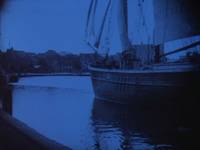 | 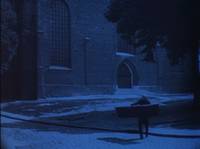 |
Nosferatu as the Raven, rodent, human form acting without mercy, without reason is seen to embody the undiscriminating horrors of the deathly virus. The dark forces of nature at hand are illustrated by films of a preying mantis plant trapping a fly and a spider in its web crawling towards its catch. By some chance of fate Helen has landed in a web and the arched back and thin black legs of Nosferatu are creeping towards her.
Walking awkwardly like a bird on land, the Count castes a dark spindly figure as he carries the coffin of soil in his arms across the harbour, towards the derelict structure of his newly acquired house. His sharp footsteps remind one of a bird of prey. There are direct references throughout the film of Nosferatu as a winged assassin. A bird like creature that makes the cry of Nosferatu to it’s victims. It is written in the gothic hand of the book of vampires. This is the midnight call of the bird of death and his cry is heard by victims shortly before being devoured. The wings of evil have flown into town.
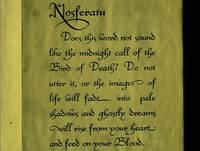 | 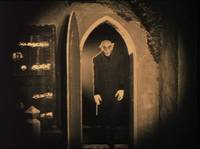 |  |
Ellen at the window
The Count is at the window opposite the bed ridden Ellen. She is lured from the bed to the window. Her arms outstretched, she is drawn to open the window. The Count stands looking through at the opposite building seeing Ellen in the flesh now for the first time, peering longingly through the window frames, hands touching the Paine.
Like a scene from Romeo and Juliet they face each other across the street. An intense love affair. A fatal attraction. The soundless space between them. Ellen flails about hand on heart in suffering silence as Hutter lies asleep on a chair in the same room. The Count freezes into an animal like pose ready to strike. He walks woodenly away from the window. Ellens’ fate is treading towards her. The Count magically opens the barn doors of his building enabling him to keep his pose as he slowly steps towards the house opposite.
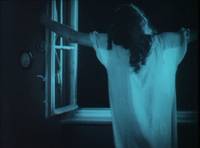 |  |  |
Art
A German gothic romantic world of striking pointed arched forms and contrasting blacks and white tones, reminiscent of German expressionist woodcuts, the image novels of Frans Masereel.
The scene near the end where Count Orlok is crouching by his victim is contructed very much like the Swiss painter Henry Fuseli’s ‘The Nightmare’ which depicts a woman in the middle of a terrifying dream. A grotesque figure perched on her chest signifying her torment. Orlock's striking bald headed features and the pointed ears seem to be influenced by this earlier image. Nosferatu is ‘The Nightmare’.
 | 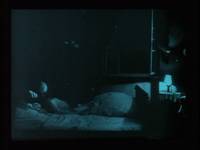 | 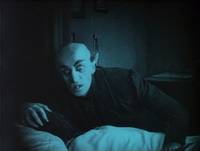 |
Text
There is relatively little spoken words throughout the film. All words work as aids to serve the collage of imagery jumping from one scroll of text to a short scene to speech text to an excerpt from a book. The various scrolls and texts taken from the original Dracula story are placed as if to read out in the theatre. The music to the film would have originally been played to the audience live before the projected film. Each performance at the time of it’s making could produce a slightly different experience. The props and artefacts are added to by the projection of coloured light behind the negative during production to signify daytime and night time. The theatrical set has been replaced by actual real landscape, Nosferatu walks off the stage and into fields, free to wander the world and find his victim. This was unusual at the time as most productions of this type were staged indoors. The real life backdrops give Nosferatu a more menacing existance, cut alongside scenes such as the funeral march through the main street in Wisberg.

Murneu presents the film as a result of research into historical events collaging different types of documentation to give credence to the story. The original Vampire books use of a collage the documentation to tell the story is again used in the film cut in between the different scenes. Apart from being just informative this devise also grounds the events in reality. The act of reading from the screen draws the viewer in and makes them interact with the narrative and is a more involving process. It is a film that could easily be read as a storyboard or graphic novel layout. Much attention has been given to the design of the inter-titles, sets and costumes, bringing them together to create a carefully crafted flow of imagery and a strong overall graphic look to the film.
 | 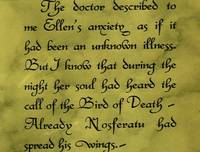 |  |
Colouring
For those who have long admired the completely black and white version of Nosferatu this new ‘completely restored’ edition could course a shock to the system. After the first few edits and text sequences you’d get used to the tints, that are actually back lit during the film making process. They don't distract from the story or the visual experience. Visually they seem to place the film more within the horror Genre. The colours could be viewed as typical of the dramatised horror of a theatre production or a freak circus show and away from the more familiar purity of black and white. Once you get used to the colour it does give the film more structure. F. W. Murnau did apparently make notes alluding to the use of colour in the film noting where the black and white should be left in. It seems strange that directors films, once made were then so open to the decisions of the manufacturers and picture houses. Murnau apparently left it up to the printer to decide on where a majority of the colouring went on the film.
The colour tinting used in this print has been coded Blue for night time and yellow for daytime. Without the tinting the vampire would still be walking around in daylight. The whole story of the film is based around the fact that Nosferatu will die if he is not in his coffin when the cock crows and the sun rises. Also the extreme black and white shadows following Count Orlok around could have been left so stark, as in the previous version, with the knowledge that these were the areas that would be tinted later in the process.
Experimental Techniques
For it’s time this film was highly experimental, using many different techniques to evoke the paranormal such as the use of one-stop animation where the vampire has the powers to lift doors and move things about the room. He also has the powers to move at incredible speed as shown in the coffin construction scene in the castle. As Hutter is being driven by coach and horses through the forest he travels at ‘frightening speed’ and the trees turn from black to white (using reverse negatives) to emphasise the unreal and dreamlike landscape he has entered after crossing the bridge into the land surrounding Count Orlok’s castle. A place where his guides will not go any further. In the original script for the film apparently there was to be a giant Raven standing by watching the coach as it went by. Also in the castle there was to be hands coming from the walls holding up candles. Supporting the idea that Murnua was attempting to visualise nosferatu as living in a dreamlike surreal world.
Albin Grau is credited for designing not just the costumes in the film but also the posters (pictured at the top of page) and the calligraphy for the inter-titles, giving the film the overall graphic feel that it has. Understanding the film as the piece of art that it is, with the obvious emphasis on the graphic black an white look of the imagery it is impossible for a third party to add anything and not distract slightly from the intentions of the original makers. The speech inter-titles are both over coloured and do not reach the exquisite style of the original. They give parts of the film a slight gaudy look. They distract from the scenes a little and would be preferred a couple of shades lighter or lower contrast with the black in keeping with the other titles.
The score is created by James Bernard who scored the Hammer films. He uses the syllables of the name Nosferatu as a theme running through out the film. The chanting of Nos-fe-ra-tu reaches different levels of pitch at different parts of the film. The sub-title of Nosferatu as ‘A Symphony of Horrors’ is matched here by an oral symphony running throughout the film. The orchestral sound rises and lowers throughout the film and greatly adds to the sense of forboding and suspense in the scenes.